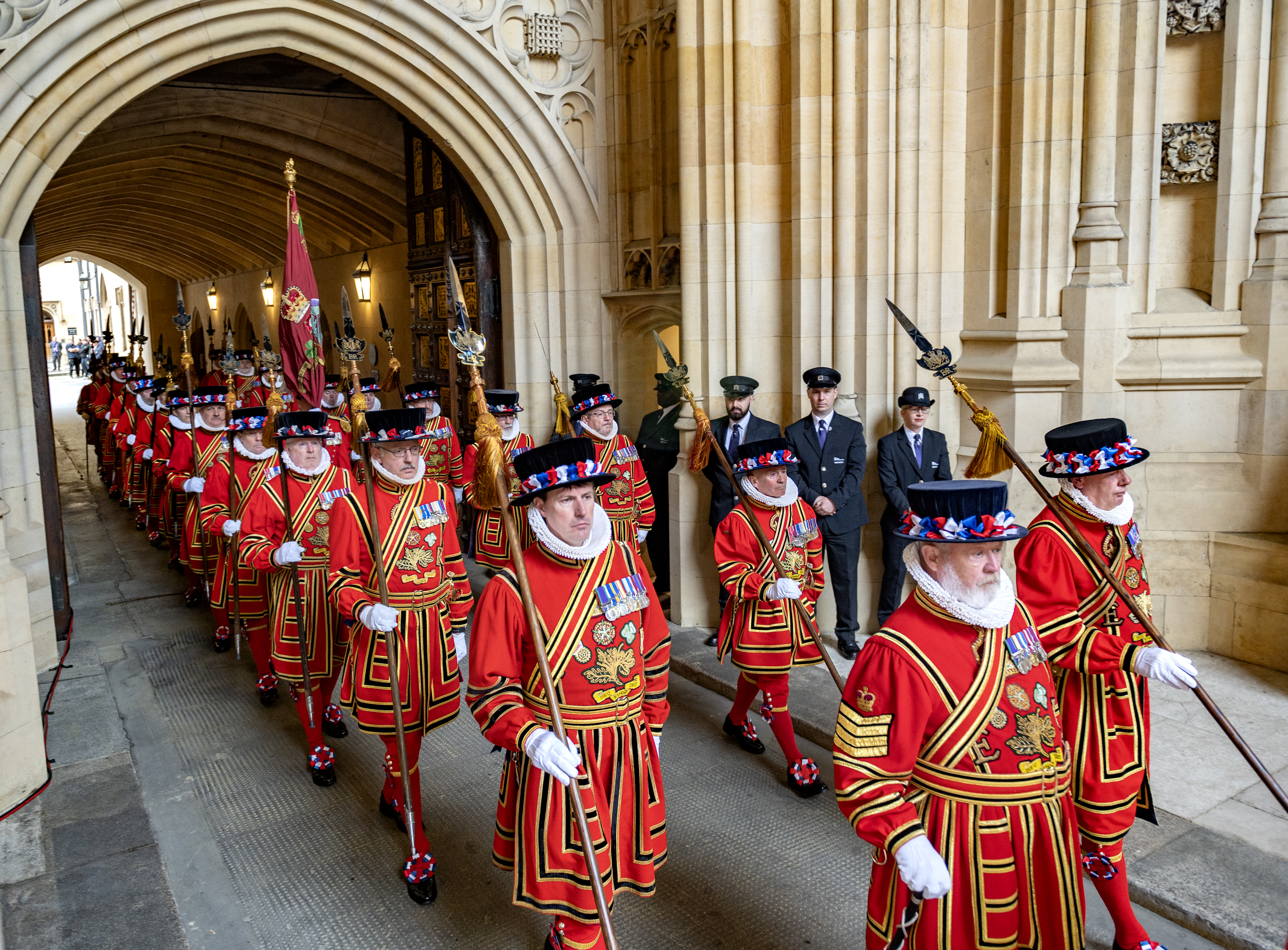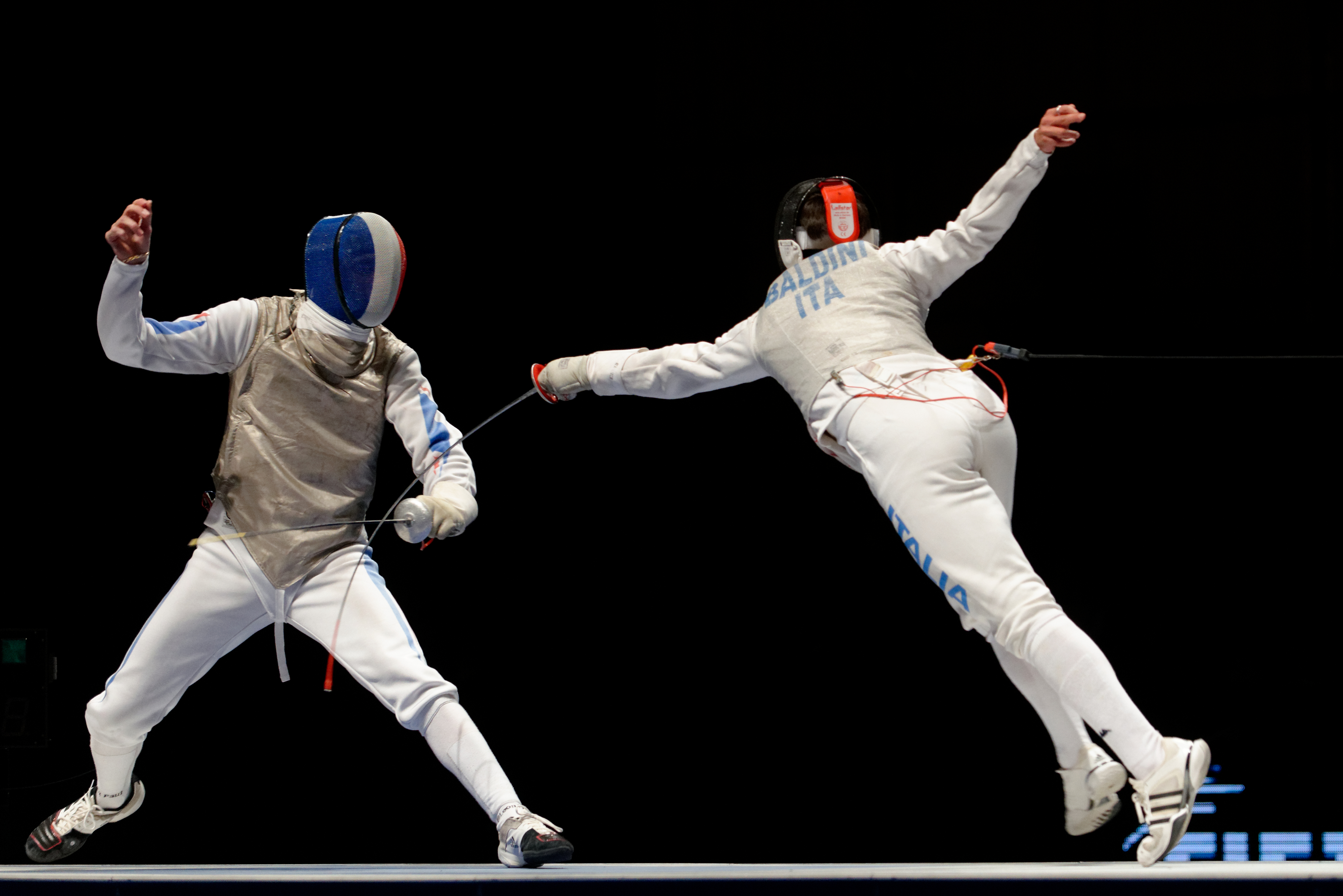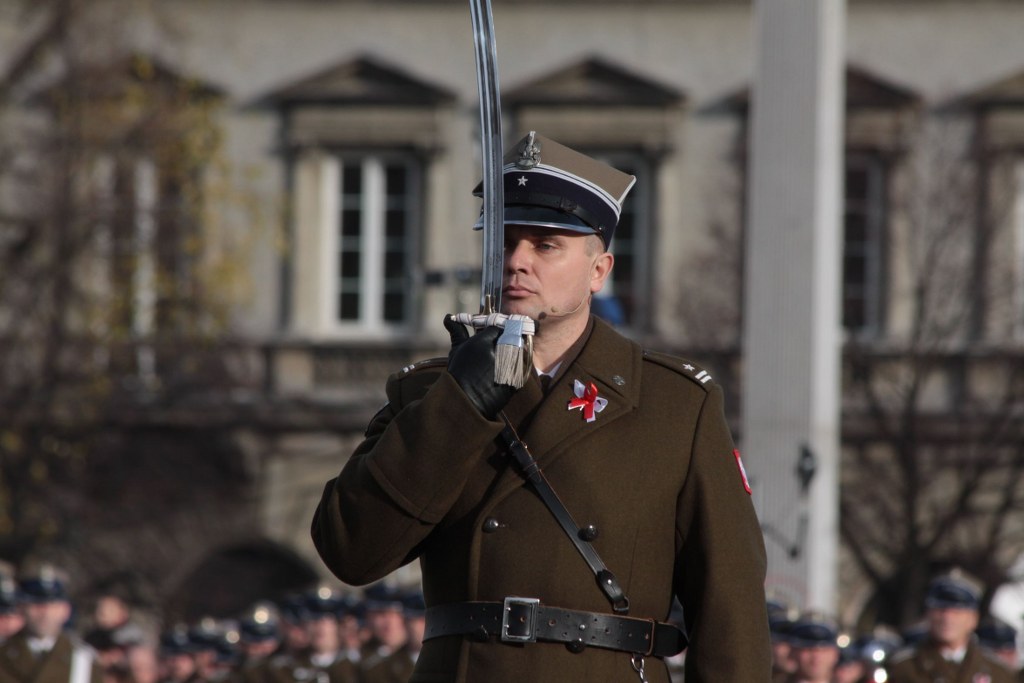|
Partisan (weapon)
A partisan (also known as a partizan) is a type of polearm that was used in Europe during the 16th, 17th, and 18th centuries. It consisted of a spearhead mounted on a long wooden shaft, with protrusions on the sides which aided in parrying sword thrusts. The partisan was often used by infantry soldiers, who would use the weapon to fend off cavalry charges. The protrusions on the sides of the spearhead were also useful for catching and trapping an opponent's sword, allowing the user to disarm them. In profile, the head of a partisan may look similar to other types of polearm, such as the halberd, pike, ranseur, spontoon, ox tongue, or spetum. The arrival of practical firearms led to the obsolescence of the partisan and other polearms. Despite this, the weapon continued to be used for many years as a ceremonial weapon A ceremonial weapon is an object used for ceremonial purposes to display power or authority. They are often used in parades and as part of dress uniforms. Althoug ... [...More Info...] [...Related Items...] OR: [Wikipedia] [Google] [Baidu] |
Yeomen Of The Guard
The King's Body Guard of the Yeomen of the Guard is a Sovereign's Bodyguard, bodyguard of the British monarch. The List of oldest military units and formations in continuous operation, oldest British military corps still in existence, it was created by Henry VII of England, King Henry VII in 1485 after the Battle of Bosworth Field. History The kings of England always had bodyguards surrounding them. The Anglo-Saxon kings had their house guards, and the Danish kings their housecarls#In England, housecarls. By the 13th century, the Anglo-Norman kings had three groups specifically ordered to protect them: (1) the royal household sergeants-at-arms; (2) the king's foot archers (also known as the Yeoman#Yeomen of the Crown, Yeomen of the Crown); and (3) the esquires of the royal household. The actual number of archers varied over the course of the 14th-15th centuries. In 1318, a Household Ordinance (the King's Proclamation containing the yearly budget for his royal household) sp ... [...More Info...] [...Related Items...] OR: [Wikipedia] [Google] [Baidu] |
Pole Weapon
A polearm or pole weapon is a close combat weapon in which the main fighting part of the weapon is fitted to the end of a long shaft, typically of wood, thereby extending the user's effective range and striking power. Polearms are predominantly melee weapons, with a subclass of spear-like designs fit for both thrusting and throwing. Because many polearms were adapted from agricultural implements or other fairly abundant tools, and contained relatively little metal, they were cheap to make and readily available. When warfare would break out and the belligerents had a poorer class who could not pay for dedicated military weapons, leaders would often appropriate tools as cheap weapons. The cost of training was comparatively minimal, since these conscripted farmers had spent most of their lives using these "weapons" in the fields. This made polearms the favored weapon of peasant levies and peasant rebellions the world over. Polearms can be divided into three broad categories: those ... [...More Info...] [...Related Items...] OR: [Wikipedia] [Google] [Baidu] |
Parry (fencing)
A parry is a fencing bladework maneuver intended to deflect or block an incoming attack. Execution To execute a parry, fencers strike the opponent's foible, or the area near the tip of the blade, with their forte, or the part of the blade near the bell guard (or handle) of the weapon. This deflects the opponent's blade away from them, protecting them and placing them in a good position to strike back. Approximations of the precise parries are made often during bouts, but are usually accurate enough to be classed as parries. In épée, because of absence of priority rules (see right-of-way), a parry can be classed as any deflection of the blade that prevents the opponent's attack from landing. Use The primary function of a parry is to prevent an opponent's attack from landing. During a bout, parries are commenced from the "en garde" (neutral) position, when an opponent's attack is considered threatening. A parry is usually followed by a ''riposte'', which is an attack back agai ... [...More Info...] [...Related Items...] OR: [Wikipedia] [Google] [Baidu] |
Halberd
A halberd (also called halbard, halbert or Swiss voulge) is a two-handed pole weapon that came to prominent use during the 13th, 14th, 15th, and 16th centuries. The word ''halberd'' is cognate with the German word ''Hellebarde'', deriving from Middle High German ''halm'' (handle) and ''barte'' (battleaxe) joined to form ''helmbarte''. Troops that used the weapon were called halberdiers. The halberd consists of an axe blade topped with a spike mounted on a long shaft. It always has a hook or thorn on the back side of the axe blade for grappling mounted combatants. It is very similar to certain forms of the voulge in design and usage. The halberd was usually 1.5 to 1.8 metres (5 to 6 feet) long. The word has also been used to describe a weapon of the Early Bronze Age in Western Europe. This consisted of a blade mounted on a pole at a right angle. History The halberd was inexpensive to produce and very versatile in battle. As the halberd was eventually refined, its point was mo ... [...More Info...] [...Related Items...] OR: [Wikipedia] [Google] [Baidu] |
Pike (weapon)
A pike is a very long thrusting spear formerly used in European warfare from the Late Middle Ages and most of the Early Modern Period, and were wielded by foot soldiers deployed in pike square formation, until it was largely replaced by bayonet-equipped muskets. The pike was particularly well-known as the primary weapon of Swiss mercenary and German Landsknecht units. A similar weapon, the sarissa, had been used in antiquity by Alexander the Great's Macedonian phalanx infantry. Design The pike was a long weapon, varying considerably in size, from long. Generally, a spear becomes a pike when it is too long to be wielded with one hand in combat. It was approximately in weight, with the 16th century military writer Sir John Smythe recommending lighter rather than heavier pikes. It had a wooden shaft with an iron or steel spearhead affixed. The shaft near the head was often reinforced with metal strips called "cheeks" or langets. When the troops of opposing armies both c ... [...More Info...] [...Related Items...] OR: [Wikipedia] [Google] [Baidu] |
Ranseur
A ranseur, also called roncone, was a pole weapon similar to the partisan used in Europe up to the 15th century. It was still seen in court as a ceremonial weapon through the 17th century. Often thought to be a derivation of the earlier spetum, the head of a ranseur consists of a spear-tip affixed with a cross hilt at its base. Often this hilt is crescent-shaped, giving it an appearance similar to that of a trident A trident is a three- pronged spear. It is used for spear fishing and historically as a polearm. The trident is the weapon of Poseidon, or Neptune, the God of the Sea in classical mythology. The trident may occasionally be held by other marine .... Generally, the hilts do not have a cutting edge, unlike the double-edged partisan. Ranseurs are generally six feet or longer. The spearing function of the weapon is apparent but not always effective against armor of great protection. The deflection includes the trapping of opponents' weapons in the space below the main ... [...More Info...] [...Related Items...] OR: [Wikipedia] [Google] [Baidu] |
Spontoon
A spontoon, sometimes known by the variant spelling espontoon or as a half-pike, is a type of European polearm that came into being alongside the pike. The spontoon was in common use from the mid-17th century to the early 19th century, but it was used to a much lesser extent as a military weapon and ceremonial implement until the late 19th century. Description Unlike the pike, which was an extremely long weapon (typically ), the spontoon measured only in overall length. Generally, this weapon featured a more elaborate head than the typical pike. The head of a spontoon often had a pair of blades or lugs on each side, giving the weapon the look of a military fork, or a trident. There were also spontoon-style axes which used the same shaped blades mounted on the side of the weapon with a shorter handle. Italians might have been the first to use the spontoon, and, in its early days, the weapon was used for combat, before it became more of a symbolic item. After the musket replaced ... [...More Info...] [...Related Items...] OR: [Wikipedia] [Google] [Baidu] |
Ox Tongue (spear)
thumb The ox tongue spear (''langue de boeuf'' or ''langdebeve'') was a type of broad-headed double-edged spear that was used in Europe Europe is a large peninsula conventionally considered a continent in its own right because of its great physical size and the weight of its history and traditions. Europe is also considered a subcontinent of Eurasia and it is located entirel ... during the 15th and 16th centuries. Some designs had protrusions from the middle or base of the blades, making the head similar in profile to a partisan. Primarily, it was large and heavy, used by infantry in skirmishing. References Spears {{Polearm-stub ... [...More Info...] [...Related Items...] OR: [Wikipedia] [Google] [Baidu] |
Spetum that was used in Europe during the 13th century. It consists of a pole, some 6–8 feet long, on which is mounted a spear head with two projections at its base. Many variations of this design flourished over time; some feel that the ranseur is a variation of the spetum. Other names include ''chauve souris'', ''corseca'', ''corsèsque'', ''korseke'', ''runka'', and ''rawcon''. The spetum is usually distinguished from the ranseur and Partisan (weapon), partisan by its "prongs" being single edged and used for slashing. The main blade is 12–14 inches long, and the side blades are only about half that length and are set at acute angles.
The design of a spetum is for combat. The main blade is long en ...
A spetum is a pole weapon A polearm or pole weapon is a close combat weapon in which the main fighting part of the weapon is fitted to the end of a long shaft, typically of wood, thereby extending the user's effective range and striking power. Polearms are predominantly ... [...More Info...] [...Related Items...] OR: [Wikipedia] [Google] [Baidu] |
Ceremonial Weapon
A ceremonial weapon is an object used for ceremonial purposes to display power or authority. They are often used in parades and as part of dress uniforms. Although they are descended from weapons used in actual combat, they are not normally used as such. Their form and, especially, their finishing and decoration are typically designed to show status and power and to be an impressive sight, rather than for practicality as a weapon. Quite often, ceremonial weapons are constructed with precious metals or other materials that make them too delicate for combat use. With ceremonial swords, an example of this is that the sword may be poorly balanced. Historically, however, many ceremonial weapons were also capable of actual combat, most notably in the military. Maces, halberds, daggers and swords are the most common form of ceremonial weapons, but in theory almost any weapon can become ceremonial. The Sergeant at Arms in some parliaments carries a ceremonial mace. The Swiss Guard in t ... [...More Info...] [...Related Items...] OR: [Wikipedia] [Google] [Baidu] |
Indonesia
Indonesia, officially the Republic of Indonesia, is a country in Southeast Asia and Oceania between the Indian and Pacific oceans. It consists of over 17,000 islands, including Sumatra, Java, Sulawesi, and parts of Borneo and New Guinea. Indonesia is the world's largest archipelagic state and the 14th-largest country by area, at . With over 275 million people, Indonesia is the world's fourth-most populous country and the most populous Muslim-majority country. Java, the world's most populous island, is home to more than half of the country's population. Indonesia is a presidential republic with an elected legislature. It has 38 provinces, of which nine have special status. The country's capital, Jakarta, is the world's second-most populous urban area. Indonesia shares land borders with Papua New Guinea, East Timor, and the eastern part of Malaysia, as well as maritime borders with Singapore, Vietnam, Thailand, the Philippines, Australia, Palau, and India ... [...More Info...] [...Related Items...] OR: [Wikipedia] [Google] [Baidu] |
Blade Weapons
An edged weapon, or bladed weapon, is a melee weapon with a cutting edge. Bladed weapons include swords, daggers, knives, and bayonets. Edged weapons are used to cut, hack, or slash; some edged weapons (such as many kinds of swords) may also permit thrusting and stabbing. Edged weapons contrast with blunt weapons such as maces, and with thrusting weapons such as spears. Many edged agricultural tools such as machetes, hatchets, pitchforks, axes, sickles, sling blades, and scythes, have been used as improvised weapons by peasantry, militia, or irregular forces – particularly as an expedient for defence. Edged weapons and blades are associated with the premodern age but continue to be used in modern armies. Combat knives and knife bayonets are used for close combat or stealth operations and are issued as a secondary or sidearm. Modern bayonets are often intended to be used in a dual role as both a combat knife and knife bayonet. Improvised edged weapons were extensively used in ... [...More Info...] [...Related Items...] OR: [Wikipedia] [Google] [Baidu] |



.jpg)


